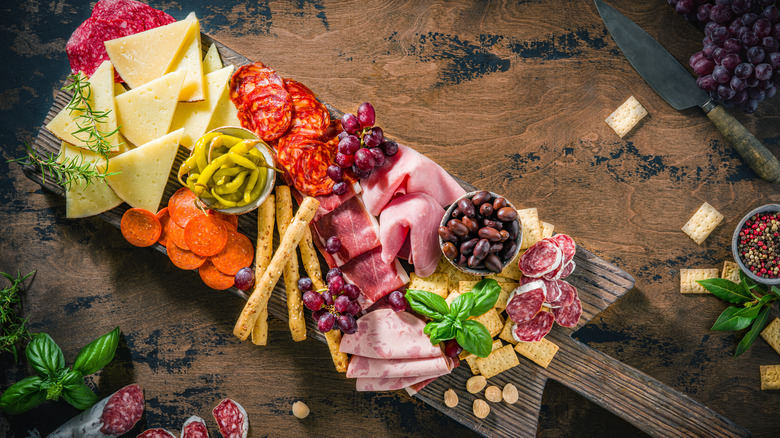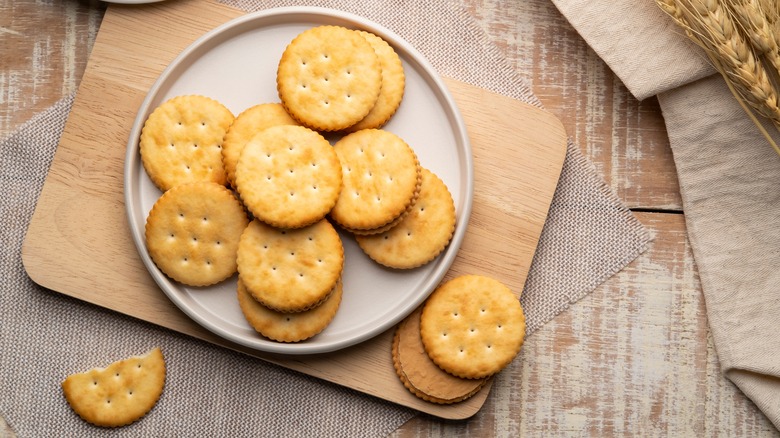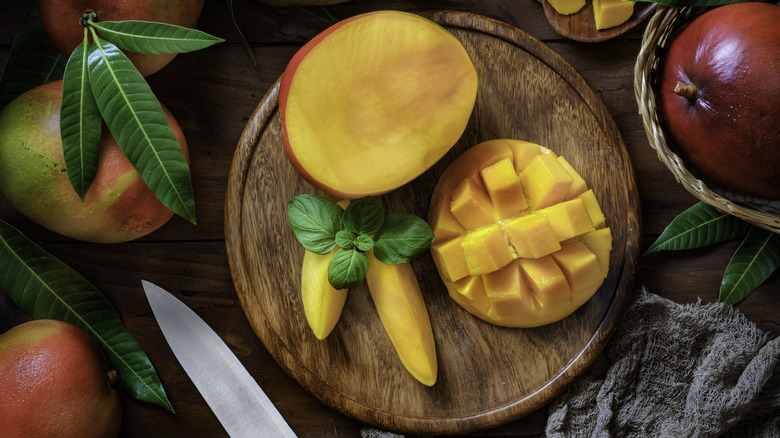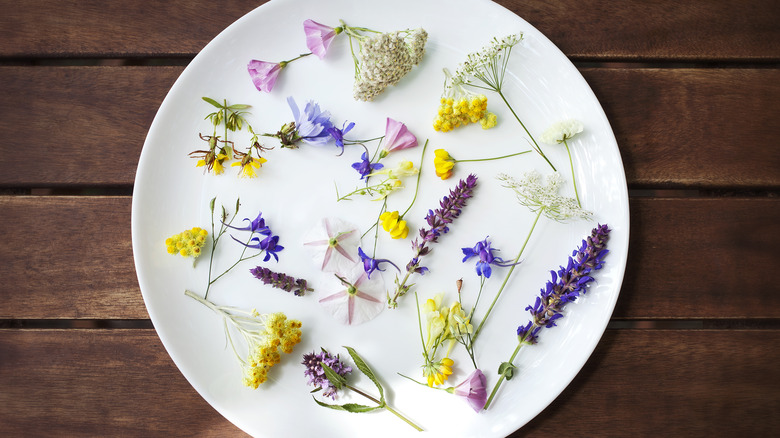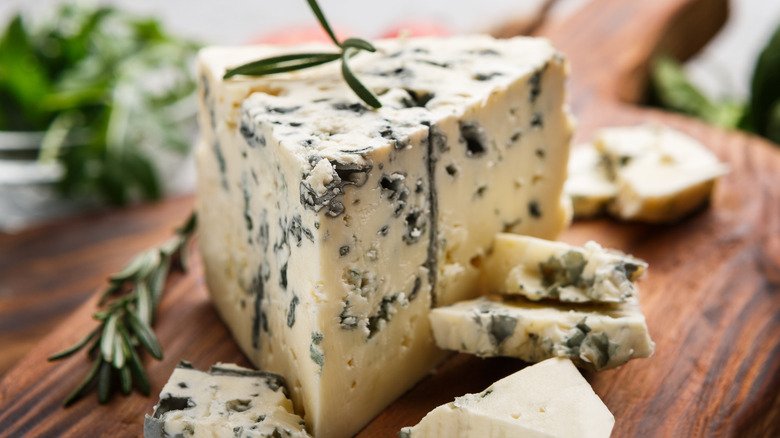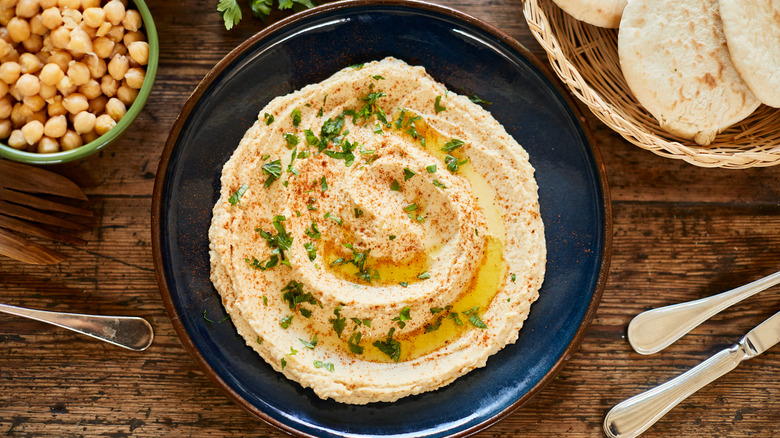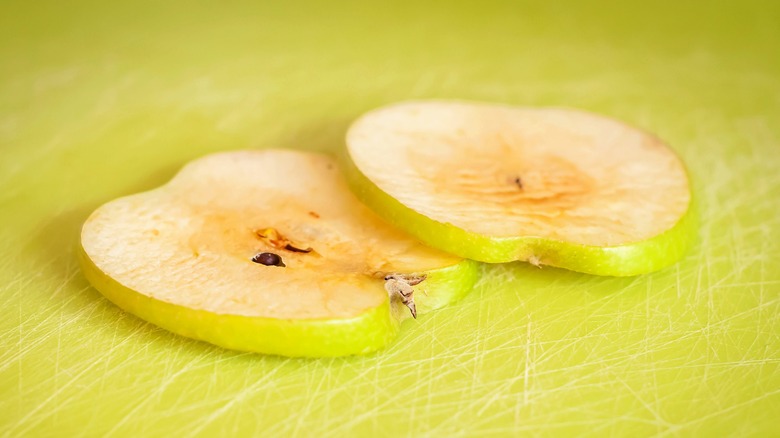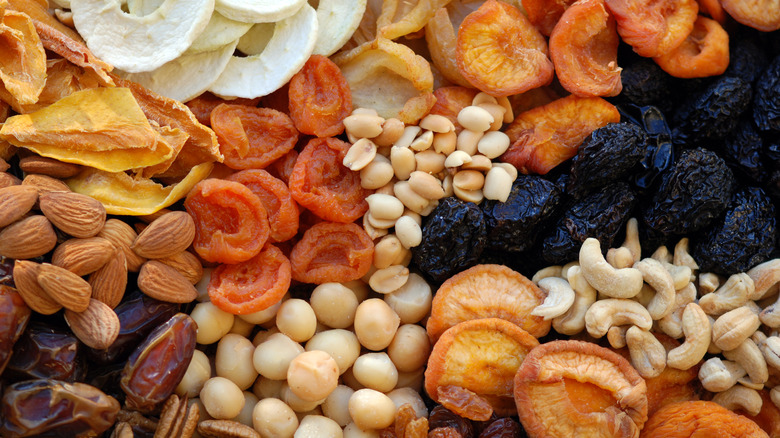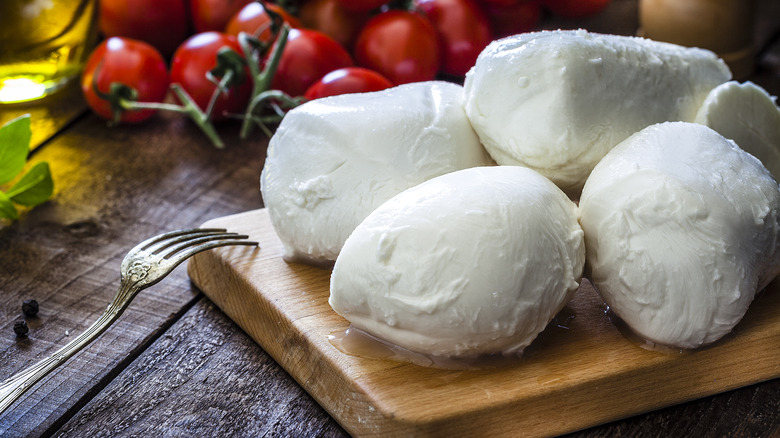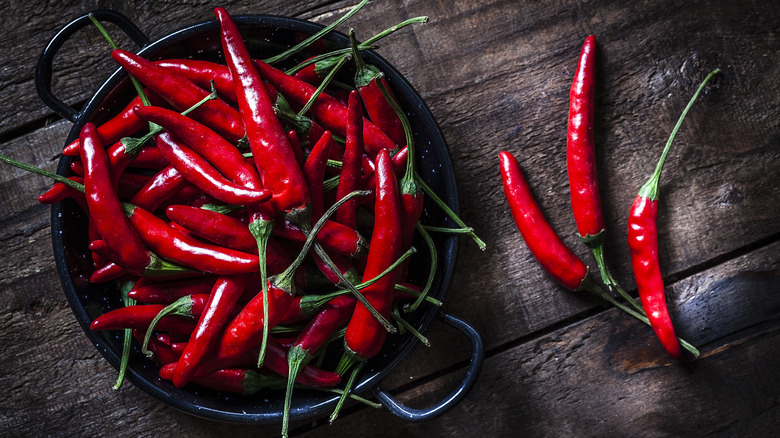9 Ingredients You Should Stop Adding To Your Charcuterie Board
What's not to love about a charcuterie board? Versatile, flavorful, and perfectly Instagrammable, a well-crafted platter is the stuff viral online content is made of. But the popularity of the charcuterie board isn't up to aesthetics alone. Their highly customizable nature is a huge part of what makes these social media standouts just as popular in the real world, too. There are endless guides to building a perfect charcuterie board, but the key is really very simple: Create a balance of flavor, texture, and color using ingredients that you love.
When it comes to crafting your ideal board, there's one important distinction to keep in mind, and that's the difference between a grazing board and a charcuterie board. While both feature an eye-catching assortment of goodies, charcuterie boards typically focus on cured meats and cheeses as their centerpiece, complemented by fruits, nuts, jams, and bread. Grazing boards, on the other hand, tend to be more diverse, incorporating just about any ingredient under the sun, from the savory (like fresh veggies and dips, fajita fixings, or buffalo wings) to the sweet (s'mores board, anyone?), with less of an emphasis on cured meats.
No matter your taste, there are endless ways to pile your preferred snacks onto a board to transform "girl dinner" into a wow-worthy centerpiece. While you can certainly stock your board with anything and everything you and your guests enjoy munching on (including some underrated additions), these are the ingredients we suggest skipping when preparing a crowd-pleasing charcuterie spread.
1. Butter crackers
Toasty, tender butter crackers are a snacker's delight all on their own, but when it comes to building the perfect charcuterie board, they're not exactly the best fit. Firstly, anyone who has ever known the disappointment of opening a sleeve of Ritz crackers only to find a crumbly mess can attest to the poor structural integrity of a butter cracker. While they might make a great casserole topping, they don't exactly stand up to the demands of supporting an array of hefty cured meats and cheeses. That tender texture is even a detriment to soft, spreadable cheeses that require an extra bit of crunch to elevate their standing on the charcuterie board.
Secondly, the rich and buttery flavor that classic butter crackers are known for is actually a bit of a weakness when it comes to charcuterie. A super-flavorful cracker can overpower the subtle (or even not-so-subtle) piquant flavors of aged cheeses, and the extra salt on the cracker's surface can turn mouthwatering meats like salami or prosciutto into unpleasant sodium bombs. You want each element on your charcuterie board to shine, not get lost in a sea of cracker-forward flavor.
So, while butter crackers are awesome for solo snacking, they might not be the best addition to your charcuterie masterpiece. Stick to something more neutral, like a plain water cracker or crusty baguette, which will let those carefully selected cured meats and cheeses take center stage.
2. Juicy fruits
Fresh fruit can be a key component of a well-made charcuterie board thanks to the wide range of textures, flavors, and vibrant colors that they bring to the party. However, you'll want to be careful in selecting your specimens — as tempting as they can be, juicy fruits can just as easily ruin your carefully laid charcuterie plans.
Take pineapple or mango, for example. When ripe, these fresh fruits are as luscious as they are colorful, bringing a pop of acid and sweetness to your spread. As the refreshing fruit sits among crisp crackers and delicate cheeses, those all-important juices begin to sweat, leaking into the nearby accouterments and leaving a waterlogged mess where hand-picked ingredients once sat. Not to mention, prepping these uber-moist tropical fruits can be a bit of a hassle — not exactly the easy, breezy, no-cook charcuterie-building experience you were hoping for.
Instead of struggling to contain rogue juices from super-ripe fruits, stick with charcuterie board classics like figs and grapes. These self-contained flavor morsels keep your board dry while also aiding in cutting through the richness of cured meats and aged cheeses. Plus, whole fruits like these require almost no prep at all — all you need to do is rinse, dry, and place them directly on the board, and voila! A photo-worthy centerpiece without any troublesome liquid.
3. Edible flowers
In the never-ending endeavor that is creating a TikTok-quality charcuterie board, it's easy to fall into the trap of choosing style over substance. Take edible flowers, for example. Sure, these kitchen-safe botanicals are technically something you can consume, but do you really want to eat a whole flower? Aesthetics aside, edible flowers really have no place on a well-constructed charcuterie board. Why waste precious space on a garnish that no one is going to eat when you could fill those nooks and crannies with more delicious goodies? Not to mention, you really don't want to spend your entire evening answering the question, "Can I eat this?"
Avoid the confusion and up the flavor ante with colorful (and delicious) accouterments instead. Look for cheeses that provide a little pop of color, like a golden Gouda or a purple-hued port wine Derby, and pile on a plethora of bright berries (another fruit option that keeps its juices self-contained) rather than reaching for other botanical extras. Strategically arranged spreads can also add color and textural interest to your board.
Try adding a jar of whole-grain mustard, earthy green pesto, and a plum-toned fig jam for some additional visual stimulation. To fill in the gaps, lean on nuts of various shades (maybe pistachios and almonds?) and more vibrant dried fruits like strawberries and apricots for an extra dose of color between all that beige. The result will be a celebration of all things delicious, with the added benefit of being visually stunning.
4. Super pungent cheeses
Charcuterie boards provide an excellent opportunity to try new gourmet offerings that you wouldn't necessarily purchase just for yourself. We're talking, of course, about those more expensive cheeses with names you might be too afraid to pronounce out loud. Before going ham in the specialty foods section, there's one rule of thumb you might want to keep in mind. When it comes to building a party-pleasing charcuterie board, remember that people's palates vary widely and not everyone enjoys a stinky cheese. While you should certainly curate your spread to suit your personal (and your guests') tastes, it's generally best to avoid super pungent offerings.
While we're all for experimentation, there are a few cheeses just too pungent to leave out in a crowded room. If you love a blue cheese, for example, skip the Roquefort and go for a mild Gorgonzola instead. And be sure to avoid cheeses with forewarning monikers, like the infamous Stinking Bishop — a cheese best savored in private.
So, why is it that some cheeses smell so much worse than others? The answer lies in the aging process. Some of the world's most pungent cheeses, like Époisses de Bourgogne and Limburger, are known as washed-rind cheeses. These specimens are continuously brined, washed, and rinsed throughout their maturation, leading to a moist, warm environment that allows specific bacteria to thrive. These bacteria are responsible for the complex, funky flavor that make these cheeses so desirable, if a bit stinky.
5. Hummus
When it comes to crafting the perfect charcuterie board, every element counts. While spreads can elevate the flavors of your chosen meats and cheeses, not all condiments are created equal. Hummus, for example, is a star in its own right, though it's not exactly a match made in heaven for a classic charcuterie spread. Sure, hummus has its place — like on a vibrant crudités platter or as part of a Mediterranean-inspired grazing board. But on a charcuterie board, it can throw off the delicate balance.
The highlight of hummus is its richness which, while undeniably tasty, can overwhelm the palate when paired with indulgent meats and creamy cheeses. That richness can leave a lingering layer of fat on your tongue that masks the flavors you worked so hard to curate. It's not just the richness of the other starring ingredients that hummus has to contend with. The dip's creamy texture and earthy flavor make it difficult to pair with most cheeses, while the delicate notes of thinly sliced charcuterie can get lost beneath a hearty helping of hummus. The negative impacts simply outweigh hummus' positive attributes, at least as far as charcuterie is concerned.
So when choosing charcuterie board extras, remember that it's all about finding balance. Opt for accouterments that complement rather than overpower. Think mustard or chutney for a tangy acidic kick or fruit-forward jams to add a touch of sweetness. By selecting the right accompaniments, you'll ensure that each element of your charcuterie board shines.
6. Fruits that brown
Presentation is everything when it comes to crafting a virtually stunning charcuterie board. Eating with your eyes is a huge part of charcuterie culture, which is why fruits that brown, like apples, pears, and bananas, can throw a wrench in your carefully curated spread. While these fruits offer great flavor and texture for pairing, their tendency to dull over time can detract from the overall appeal of your charcuterie masterpiece.
So, what's the deal with fresh fruit turning brown? It's all about oxidation. When you cut into a piece of fruit, you're exposing its flesh to oxygen in the air. This triggers an enzymatic reaction involving polyphenol oxidase (PPO), a natural enzyme found in plant tissues, which causes the fruit to brown. This browning is thought to be a completely natural defense mechanism to protect the newly exposed flesh, but it's not exactly ideal for your picture-perfect charcuterie board.
The good news is there's a simple trick to slow down this process: citrus. Coating exposed fruit with lemon, lime, or other citrus juice can help delay enzymatic browning, though prolonged exposure may still lead to some discoloration. While apples and cheese might make a tasty combo, for example, it's best to save this pairing for a more private snacking session rather than a centerpiece charcuterie board meant for an extended grazing affair. When it comes to fruit selection for your spread, opt for varieties that won't leave you seeing brown.
7. Sweetened dried fruits
Dried fruits can be the unsung heroes of a well-made charcuterie board, bringing visual interest in the form of color and texture, as well as a pleasant chew that provides a nice contrast to the crunchy and creamy elements already found on your spread. But when it comes to selecting dried fruit, one of the biggest mistakes to avoid is buying sweetened versions of those delicious bites.
On the flavor front, sweetened dried fruits can be sugar bombs, overloading your palate with sweetness and overpowering the nuanced notes of quality charcuterie and beautifully aged cheeses. It might even feel like you're munching on candy instead of wholesome fruit. Healthwise, there's a big difference between natural dried fruits and their sweetened counterparts. Natural dried fruits retain all the good stuff from fresh fruit, like antioxidants and fiber, while sweetened versions can be loaded with empty calories and added refined sugars, which can spike your blood sugar levels and cause you to crash before the party is over.
So instead of being tempted by the sweeter stuff, reach for the natural dried fruits for your charcuterie board. Look for "no sugar added" labels — when in doubt, check the sugar content on the nutrition label — on those packages of dried fruit to enjoy a punch of sweetness and chewiness without any extra additives. Plus, they're packed with nutrients like fiber, vitamins, and minerals, making them a healthier option among the (admittedly) sodium-rich offerings spanning your charcuterie board.
8. Mozzarella
In the wide world of cheese, mozzarella doesn't exactly rank at the top when it comes to flavor. While mozzarella is delicious in the right context, especially when it's fresh and creamy, a charcuterie board just isn't the right place for this underwhelming cheese.
Charcuterie boards thrive on texture variety, from creamy cheeses to crunchy nuts and crispy crackers. But mozzarella is like the wallflower at the party — it doesn't really stand out in a crowd. Its soft texture lacks the contrast and richness that other cheeses bring to the table. And while mozzarella's flavor is subtle and milky, it can get lost amidst the bold and savory flavors of cured meats and more pungent cheeses. Plus, there's the moisture issue. Mozzarella has a relatively high moisture content, which can make your crackers soggy if it's not properly drained before being placed on the board.
The exception to the mozzarella rule? Burrata. What's the difference? One of the internet's most popular cheeses has value in its dramatic presentation and can have a bit more textural interest than plain mozzarella thanks to a filling of cheese curds and cream that provides an indulgent bite when spread over toasty bread. Don't be mistaken, mozzarella is a great cheese in its own right. It's perfect for pizzas and caprese salads, but when it comes to charcuterie, it just isn't a star player. Skip the mozz and use that space instead for more flavorful soft cheeses like Brie, feta, or creamy goat's cheese.
9. Hot peppers or chiles
We love a bit of well-placed produce on an artful charcuterie board. Both pickles and peppers are prime accompaniments to cured meat that also bring vibrant hues and a pleasant crunch to your spread. However, be careful when it comes to the hot stuff — unless your entire crew is into the super spicy end of things, you'll want to stick to the mild side.
Opinions can vary widely on what is considered "spicy," so when cooking for a crowd, it's best to avoid any potential issues caused by even common peppers like jalapeños or other different types of fresh chiles like serranos. Depending on how much heat you can tolerate on the Scoville scale, the capsaicin reaction on your tongue can keep you from tasting the more subtle notes of the piquant cheeses, delicate cured meats, and — perhaps most importantly — the accompanying wine. And should the juices from any of these hot peppers or chiles end up spilling over onto the other ingredients on your board, the results could be anything but pleasant.
Those looking to spice up their charcuterie spread should look instead to their cured meat selection to bring the heat. Pick one or two pepper-infused meats like spicy capicola, soppressata, or nduja to add to your board a one-two punch of savory spice. Just be sure to label the hot meats appropriately to avoid any mishaps.
